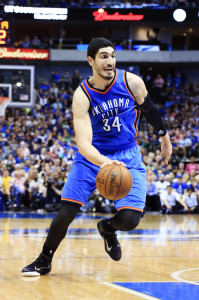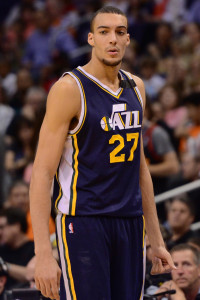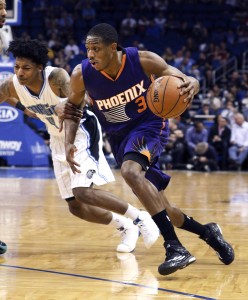Guaranteed Contracts
- Kevin Durant ($20,158,622)
- Russell Westbrook ($16,744,218)
- Serge Ibaka ($12,350,000)
- Dion Waiters ($5,138,430)
- Steve Novak ($3,750,001)
- Nick Collison ($3,750,000)
- Anthony Morrow ($3,344,000)
- Jeremy Lamb ($3,034,356)
- D.J. Augustin ($3,000,000)
- Steven Adams ($2,279,040)
- Perry Jones III ($2,038,206)
- Mitch McGary ($1,463,040)
- Andre Roberson ($1,210,800)
Non-Guaranteed Contracts
Options
Restricted Free Agents/Cap Holds
Unrestricted Free Agents/Cap Holds
Other Cap Holds
- No. 14 pick ($1,684,600)
- (Josh Huestis $950,200)2
- (Derek Fisher $947,276)3
Draft Picks
- 1st Round (14th overall)
- 2nd Round (48th overall)
Cap Outlook
- Guaranteed Salary: $78,260,713
- Non-Guaranteed Salary: $0
- Options: $0
- Cap Holds: $17,696,427
- Total: $95,957,140
The last day of Kevin Durant‘s contract is still more than a year off, but the Thunder brass has been dropping hints for months that it already feels the pressure. The calendar year of 2015 has been the most tumultuous for the Oklahoma City organization since the James Harden trade in 2012. The team dealt away Reggie Jackson and two future first-round picks in trades that brought back Enes Kanter and Dion Waiters, among others, and took the team over the luxury tax threshold. The Thunder replaced coach Scott Brooks after nearly seven seasons with NBA coaching neophyte Billy Donovan. And injuries that cost Durant, Russell Westbrook, Serge Ibaka and others significant time left the team out of the playoffs for the first time since the franchise’s first season in Oklahoma City.

Courtesy of USA Today Sports Images
Still, the summer ahead allows GM Sam Presti to take a breath, if he chooses. Durant’s broken right foot is healing, the trades the team made during the season strengthened the team’s supporting cast, and no one on the roster can elect unrestricted free agency this year. Presti could have the same 15 players who ended the season on the roster back for opening night of the 2015/16 season if he wants to. It seems more likely there will be at least a slight degree of turnover, if for no reason other than the presence of this year’s No. 14 overall pick in the team’s quiver.
The Thunder aren’t a typical lottery team, so they’re as apt as any to value prospects who are ready to contribute immediately. So, raw talents like Texas center Myles Turner and Kansas small forward Kelly Oubre, both of whom have decent chances to be available when the 14th pick comes around, don’t appear to be fits for Oklahoma City. Arizona small forward Rondae Hollis-Jefferson is a more tempting possibility as a defensive-minded complement to Waiters if the Thunder is confident that Hollis-Jefferson can swing over to shooting guard. Still, neither Waiters nor Hollis-Jefferson is a strong three-point shooter, so that would invite defenders to clog the lane for Durant and Westbrook. Kentucky two-guard Devin Booker would give the team plenty of outside shooting, but he’ll probably go off the board a few picks before the Thunder would have a chance to grab him.
Perhaps the choice who makes the most sense is Notre Dame point guard Jerian Grant. He was a passable three-point shooter in college, knocking down 35.7% of his attempts in his first three years before he slumped to 31.6% this year. Moreover, he’s an NBA-ready point guard with four years of college under his belt who can score, as his 17.1 points per game across his junior and senior seasons demonstrates. The Thunder are set at backup point guard with D.J. Augustin, but Grant, at 6’5″ with a 6’7.5″ wingspan, would be a fit alongside Westbrook in two point guard sets. Our Eddie Scarito has the Thunder going with another point guard, Murray State sophomore Cameron Payne, in the Hoops Rumors Mock Draft.
The Thunder’s decision about whom to draft may well involve more work than the one surrounding their most notable free agent. Presti has made it obvious that he wants to retain Kanter, and so it appears Oklahoma City is willing to pay a premium to make it happen. A max offer from another team would probably make Presti think twice, but it still seems likely that the Thunder would match to keep a center who put up 18.7 points and 11.0 rebounds in just 31.1 minutes per game across 26 appearances after the trade that brought him to Oklahoma City. That’s a small sample size, and his defensive shortcomings are profound. Still, offensive production like that at the center position has long made front office personnel salivate. The Thunder would probably target a deal like the four-year, $48MM extension the Magic signed this past fall with Nikola Vucevic, who similarly excels at scoring and rebounding while playing subpar defense. Vucevic hadn’t displayed the knack for scoring before this season that his fellow native of Switzerland did in his time with the Thunder, so that may be the difference that ultimately drives up Kanter’s value.
The Thunder have reason to match even a max offer since, with commitments for next season that already take them well past the projected $67.1MM salary cap, they wouldn’t have means to replace Kanter with another comparable free agent, as The Oklahoman’s Darnell Mayberry recently noted. The same logic applies to Kyle Singler, Mayberry argued, though surely Singler won’t be drawing interest for the max. A logical limit, probably somewhere around the equivalent of the $5.464MM non-taxpayer’s mid-level exception, surely exists to the Thunder’s willingness to pay Singler to return. Even that would probably be too much for a player who Basketball-Reference’s Box Plus/Minus and ESPN’s Real Plus/Minus indicate is a minus on both ends of the floor. He’s nonetheless done enough to stick on the court as a rotation player and occasional starter during his three NBA seasons, and he has value as a floor spacer, but that duty could fall to Steve Novak if Singler receives an offer from elsewhere that the Thunder feel compelled to pass on.
Still, the Thunder would like to re-sign Singler, and that makes it tougher to envision the team finding room on the roster to sign Josh Huestis, last year’s first round pick, whom the Thunder stashed in the D-League as part of an unprecedented arrangement. Huestis isn’t making a fuss about the idea of staying with the Thunder’s D-League affiliate for one more year, and even if he did, he’d have little leverage. The worst-case scenario for the Thunder is that he leaves their D-League team for a more lucrative deal overseas and develops there, but Oklahoma City can control his NBA rights in perpetuity if it wants to.
If Huestis does sign with the Thunder this summer, that will almost certainly require the Thunder to trade one of their 13 players with fully guaranteed salaries for next season. A majority of Hoops Rumors readers who voted in a recent poll said the Thunder need major changes around Durant if they’re to win a title next season, but making moves that significantly upgrade the team is easier said than done. Westbrook would presumably be untouchable, but the Thunder could gauge the market for what it would bear in a sign-and-trade involving Kanter, to see if other teams still believe Waiters can live up to having been a No. 4 overall pick, or even to see what Ibaka would fetch. Some combination of those three would make a pretty tempting offer for a star if one became available, but no marquee names seem to be on the block at this point.
A smaller-scale trade is much more likely, though Waiters, who struggles on defense and with his outside shot, bears watching if there is indeed a team still enamored with his potential. Possible trade candidates include Mitch McGary, who was effective in the meager playing time he saw, especially on the boards. In spite of McGary’s 16.6 PER this past season, the Thunder would have difficulty finding more playing time for him this coming season if they re-sign Kanter. There’d be little use for Novak, especially if Singler returns, but Novak remains a dead-eye three-point shooter who’s going into the final year of his contract. Perry Jones III has barely seen playing time over his three years with Oklahoma City, but he’s a former first-round pick, and he, too, is entering a contract year.
Jones, along with Lamb and Waiters, is one of three members of the Thunder up for rookie scale extensions this offseason, but only Waiters will likely merit any consideration for one. That’s still a tricky proposition for Oklahoma City, which doesn’t know whether it will still be building around Durant come 2016/17, the season that an extension for Waiters would kick in. Committing money for Waiters would stand to complicate matters if Durant leaves and the Thunder are trying to retool. Waiters’ trade value is probably as low as it has been since he entered the league, so the Thunder could get a discount if they’re high on his potential, but Waiters may well hesitate to bet against himself like that.
Presti has to think about a future without Durant even as he does everything in his power to keep the four-time scoring champ. The team’s moves of the past several months signal his thinking along that dual track, as the talent he’s added has chiefly been younger and still developing, as Kanter exemplifies. The big man can boost the team’s title chances for next season and help in the long run, with or without Durant, if the Thunder re-sign him this summer. The stakes are incredibly high for the Thunder next season, but barring the emergence of a superstar trade candidate on another team, they’ve done just about all they can to set themselves up for success while still preparing for the worst.
Cap Footnotes
1 — The cap hold for Singler would be $2,071,000 if the Thunder elect not to tender a qualifying offer.
2 — The team may remove the cap hold for Huestis, the 29th pick in the 2014 draft, if both sides agree in writing that they will not sign a deal during the 2015/16 season.
3 — See our glossary entry on cap holds for an explanation why Fisher technically remains on the books.
The Basketball Insiders Salary Pages were used in the creation of this post.





